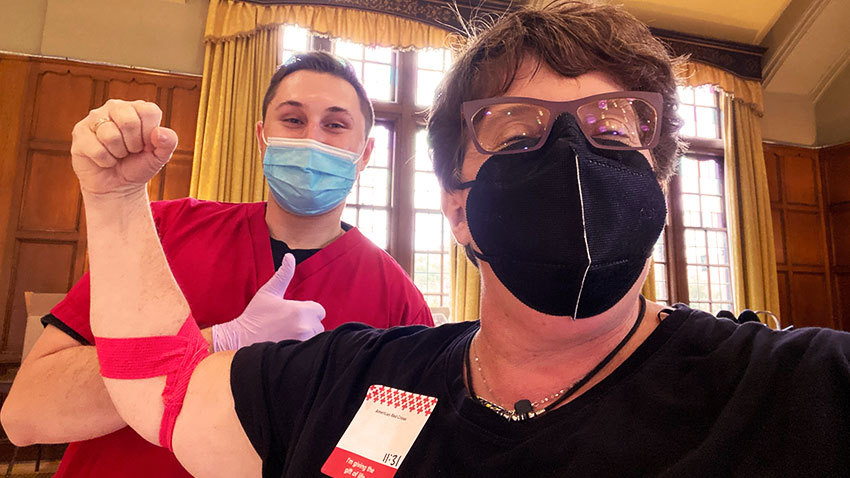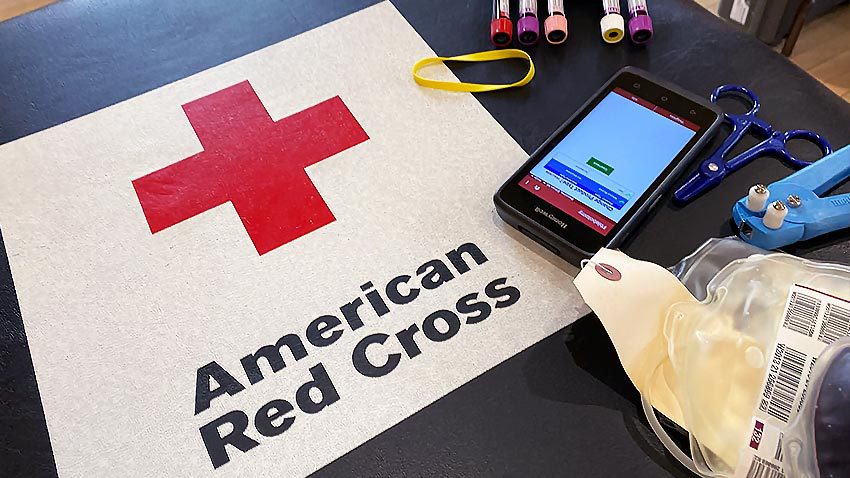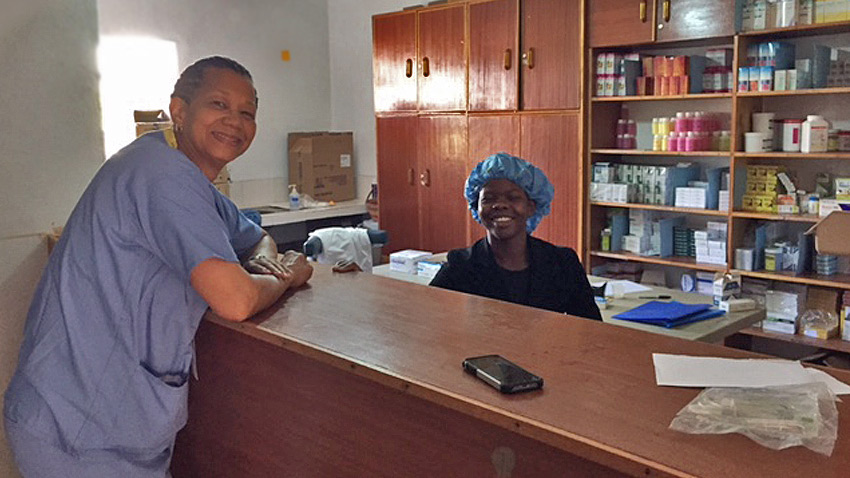What it’s really like to give blood
经验丰富的献血者分享了期望以及如何准备。

Lying down. Eating snacks. Saving lives.
Really, what’s not to like about giving blood?
After all, you have something inside you that no factory can make, and that a lot of people need in order to survive. You can give it safely, in about an hour, and you’ll barely feel a thing.
我提到小吃了吗?他们是免费的。血液驱动人员和志愿者的友好笑容也是如此(您真的可以说他们在口罩上微笑。)
Also free? The feeling that you’re helping your fellow humans, though you’ll never know exactly which ones.
I’ve been donating blood for decades, a few times a year, even through the pandemic (and是的,即使在我的三种vid疫苗剂量之后.)
I’ve even got a pin to prove that I’ve given five gallons of my blood, which works out to about 40 donations.
因此,我收集了一些我最喜欢的有关献血的内部技巧。
If you’ve never given blood, or you did it long ago but stopped, this is a great time to start. There’s actually a shortage of blood right now, and blood banks are pulling out all the stops to bring in more donations before people get busy during the holiday season.
Take, for instance, theBlood Battle between the University of Michigan and Ohio State University. It’s a contest to see which school can bring in the most blood donors in the month before the football rivals meet on the field.
I’m proud to say I scored a point for U-M this week by giving at a drive on campus. There areplenty of blood donation appointments still openbefore the competition ends November 24.
你为什么要流血?
Just a few miles away from the U-M stadium sits the main campus of U-M’s Michigan Medicine. The patients who come to our hospitals and clinics need an incredible amount of blood every day.
这Blood Bankdirector, pathology professor罗伯逊·达文波特(Robertson Davenport),医学博士领导一个与红十字会紧密合作的团队,以确保我们有足够的血液,血小板和血浆来治疗患者cancer and sickle cell disease to heart surgery, liver failure and severe car crash injuries.
Even some COVID-19 patients get blood products, especially those onthe life-support system called ECMO.
MORE FROM MICHIGAN: Sign up for our weekly newsletter
“Michigan Medicine uses about 32,000 units of red blood cells, 15,000 units of platelets, and 7,000 units of plasma annually,” Davenport told me. “Major clinical services that rely on blood transfusion include heart surgery, including coronary artery bypass surgery and heart valve repair; cancer care such as leukemia and bone marrow transplantation; congenital heart surgery for infants and children born with heart defects; transplant surgery to replace failing livers, lungs and hearts; and emergency services for trauma and acute bleeding.”
He cited just a few recent examples of patients who needed a large amount of blood:
一个患有心脏缺陷的十几岁女孩,患有感染,需要更多的心脏手术。
A middle-aged man who needed a second lung transplant after his first transplant failed.
A young man with a history of leukemia who received a bone marrow transplant but suffered acute bleeding.
A young woman who came to the emergency department with acute intestinal bleeding.
An older man with acute leukemia and an infection that he couldn’t fight off.
一个接受新肝脏的中年男子取代失败的肝脏。

成功献血的提示
1. First, figure out if you’re eligible to donate blood
的确,红十字会和其他收集的机构不仅会吸收任何人的鲜血。他们必须确保捐助者的捐赠是安全的,并且可以让接收者获得安全。
Still, while about 38% of Americans meet all the criteria to give blood, only 10% actually do it. That’s why shortages happen.
So it’s time to check theblood donation eligibility guidelines如果您假设自己没有资格,或者由于纹身或刺穿,旅行或服用药物而过去没有资格。指南已经改变!
如果您是LGBTQ+社区的成员,请参阅您的特殊页面(and note that the U.S. Food and Drug Administration is working with the Red Cross to evaluate potential changes to its donation guidelines for gay and bisexual men.)
如果您最近接种了Covid-19,则在美国或加拿大批准使用的任何疫苗的第一,第二或第三剂量不必须等待献血。等待期已于今年早些时候删除。您也不必在获得流感疫苗或大多数其他疫苗接种后等待(检查资格标准可以肯定。)
如果您最近参加了Covid-19,则需要等到阳性测试或症状后的几周后才能捐款。
也可以看看:Feeling Helpless as the Pandemic Continues? 26 Things You Can Do to Help
我不时绊倒我的资格标准之一是血液中的血红蛋白水平与铁的水平有关。实际上,这很常见,尤其是对于女性而言,红十字会提供有关why it’s important and what you can do.
Each donor gets a rapid hemoglobin test as part of the pre-donation process, but you don’t want to make the trip to a donation site only to find out your level is too low.
So, I take an iron supplement and a vitamin C supplement to help my body absorb the extra iron, and I try to eat iron-rich foods in the weeks before a donation. If you think you might have low iron, talk to your health care provider about whether you should take a supplement.
Like Podcasts? Add theMichigan Medicine News BreakoniTunes,Google Podcastsor anywhere you listen to podcasts.
2.挑选您的日子和时间,并在给血之前几天“赛前”
这Red Cross has aneasy-to-use online scheduling systemthat lets you find a blood donation time and location that’s convenient for you (you may live in an area served by another blood-gathering organization, but they likely have one too.)
Most donations take about an hour from start to finish, but with COVID precautions and staff shortages this can stretch out a bit longer at peak times. So don’t book a donation time that starts an hour before a crucial meeting or when you have to pick someone up.
专业人员感觉献血时你最好的:
I try to pick donation times after lunch, so I can have a meal about half an hour to an hour before I arrive. This gets sugar into my bloodstream so I’ll be less likely to feel woozy after I give. But no matter what time you give, make sure to have at least a snack before you go.
这day before your appointment, you’ll get an email nudging you to take care of the pre-donation questionnaire and get a digitalRapid Passthat will speed your way through the donation process. This just takes a few minutes and includes important information about eligibility that might be specific to your area (such as whether you were informed you ate at a local restaurant associated with a hepatitis A outbreak).
This tip is crucial:Start drinking extra water a few days before your appointment. Getting fully hydrated will plump up your veins and make your donation go more smoothly.
到预约的那天,您应该变得如此富裕,以至于您的尿液几乎无色,并且发现自己需要浴室休息时间比平时更频繁。另外,避免在约会当天避免使用咖啡,茶,可乐或其他含咖啡因的饮料和食物,因为它们会使您的身体更快地摆脱水。
Plan your outfit: Short sleeves, or sleeves you can unbutton and roll to above your elbow, are a must. You can wear a sweater or jacket before and after you donate. Don’t wear a skirt or dress because it’s not easy to get on and off the high donation cot in one. (I found that out the hard way. Never again!) Super-tight jeans or waistbands aren’t a great idea either.
3. Know what to expect at your donation:
If you want a great detailed explanation of what happens at a blood donation appointment, the Red Cross offersa full blow-by-blow.
Check out the list below for a quick run-down of what you can expect along the way.
Blood donation preparation checklist:
带上您的身份证,以确保您是您的。如果您有过去捐款的捐赠卡,也要带上它。
戴口罩。献血动力是医疗保健环境,因此可能需要,尽管这可能会根据当地的案例率而改变。
Bring your smartphone or something to read in case you have a bit of a wait.
如果你不提前做快速通过,意图dy to go over all the eligibility questions about your health and travel history, and other topics, on the computer of the staff member assigned to you.
即使您确实进行了快速通行证,您仍然还有一些问题要回答。Be honest about everything they ask – they will keep the information confidential.
如果您与朋友在一起,并因您的回答是如何回答问题而被捐赠的,但是您不想告诉朋友原因,您可以说这是低铁或其他东西。
If you’re concerned you might have low iron, ask them to test your hemoglobin first before you invest too much time in the appointment. This involves a pinprick on one of your fingertips to get a drop of blood. If your level is too low on the first try, they can test it one more time from a different finger.
You’ll get your temperature, pulse and blood pressure taken – so basically, giving blood includes a free health screening!
Remember to keep your feet flat on the floor, your body relaxed and your breathing calm when they take your blood pressure.
If you’re anxious about needles, use distraction to keep yourself from worrying. Enjoy the sound system that’s playing upbeat music. Trade stories or crack jokes with the staff (they have a long day on their feet). Do some patterned breathing. And tell the staff that you’re not a fan of needles so they can help you through the process.
这y’ll ask you which arm you want to give from. Some people prefer to try to give from their non-dominant arm, but honestly there is no pain afterward so it should not matter. And sometimes the easier-to-access veins are on your dominant arm, so using it might make things go more smoothly to use that one.
What it’s like to donate blood, step by step:
这staff will put a blood pressure cuff on you and narrate every step of the process, from using a marker to outline the vein they’ll use, to cleaning your skin to prevent infection, to inserting the needle and telling you when to squeeze or roll the soft roller or squishy ball they’ll put in your hand.
这needle goes in on the inside of your elbow, and staff are excellent about doing it as quickly and painlessly as possible. Thankfully there really aren’t many nerve endings in that spot, so it’s more like a moment of discomfort than pain.
Once you’ve started the actual donation, you’ll be surprised at how quickly it goes – 15 minutes or so depending on the size of the vein and how hydrated you are. You need to keep rolling that object in your hand to keep the blood flowing. You can read something on your smartphone in your other hand to pass the time.
一个关键提示:在您实际捐款时不要说话或笑很多;这会耗尽您的血液中的氧气,使您在完成并坐起来时更有可能变得昏昏欲睡。
这y’ll stop your donation after they’ve collected about 500 milliliters of blood, which is about 2 1/3 cups. Since your body has about 1.5 gallons of blood, this is an absolutely safe amount to take.
Most of the blood goes into a bag, but before you’re done they will also collect small amounts in a few vials, for testing.
完成后,他们会毫不痛苦地将针头拔出,将纱布放在针头上,让您按下它并抬高手臂以加速插入点的凝结。然后,他们将绷带放在上面,并使用红色纱布包裹将其固定在适当的位置。在接下来的一个小时左右的时间里,以骄傲为生!将绷带放置一会儿。
If you’re squeamish about seeing your own blood in the collection bag, don’t worry – it hangs down the side of the cot while you’re giving, and once they’ve clamped it off and laid it on the cot, you can easily pivot out of the way once you sit up and not ever see it.
Listen to the instructions they give you about avoiding alcohol or caffeine that day, as well as lifting heavy things or exercising. There’s a reason for these instructions! Consider this a free pass to take it easy for the rest of the day – but be sure to keep drinking water to replace the fluids you’ve lost.
保留他们给您的纸张,该纸张具有特定于您的独特条形码,如果您出现任何症状,可以调用一个数字。例如,如果您捐赠后的第二天开始,您需要立即告诉他们,这样他们就不会向可能更容易受到这些感染的人提供血液。
如果您感到微弱或不太正确,请告诉他们。您可以坐在婴儿床上更长的时间,或者去零食区附近的恢复婴儿床。
That’s it!
Now you can enjoy those snacks and juices that the nice volunteer will offer you in the recovery area. Don’t feel greedy if you want a second helping.
坐在零食桌上呆了15分钟,双脚都放在地板上,对于确保您还可以在回到一天之前就很重要。它还给了一些零食和果汁中的一些糖进入您的血液。
And when you do leave, pat yourself on the back. You just gave enough blood to save up to three lives.
您甚至可以通过Red Cross app,得到警报哪些医院它结束了p at after testing and processing.
And while you’re on the app, make your next donation appointment, for at least two months from now, or longer if your iron levels were on the low side.
And that’s how you can keep the cycle of giving blood – and saving lives – going.





